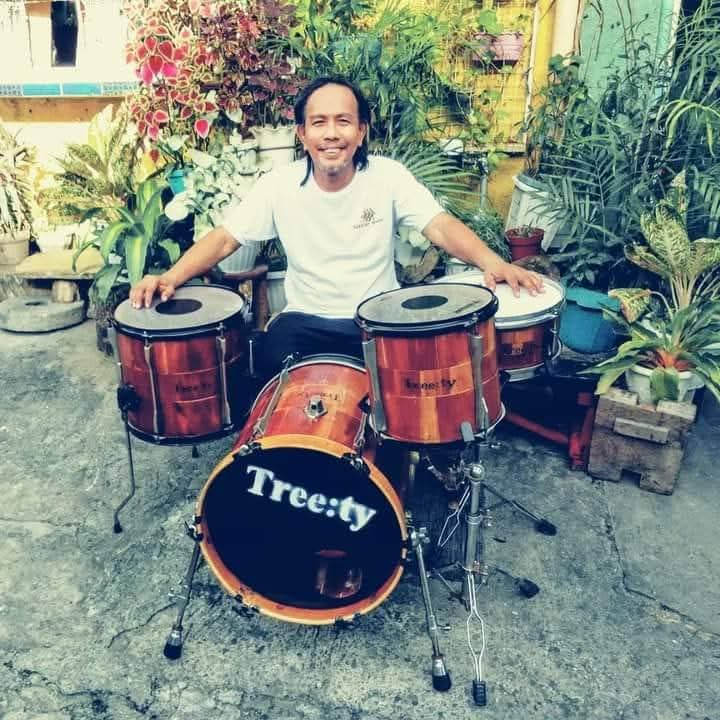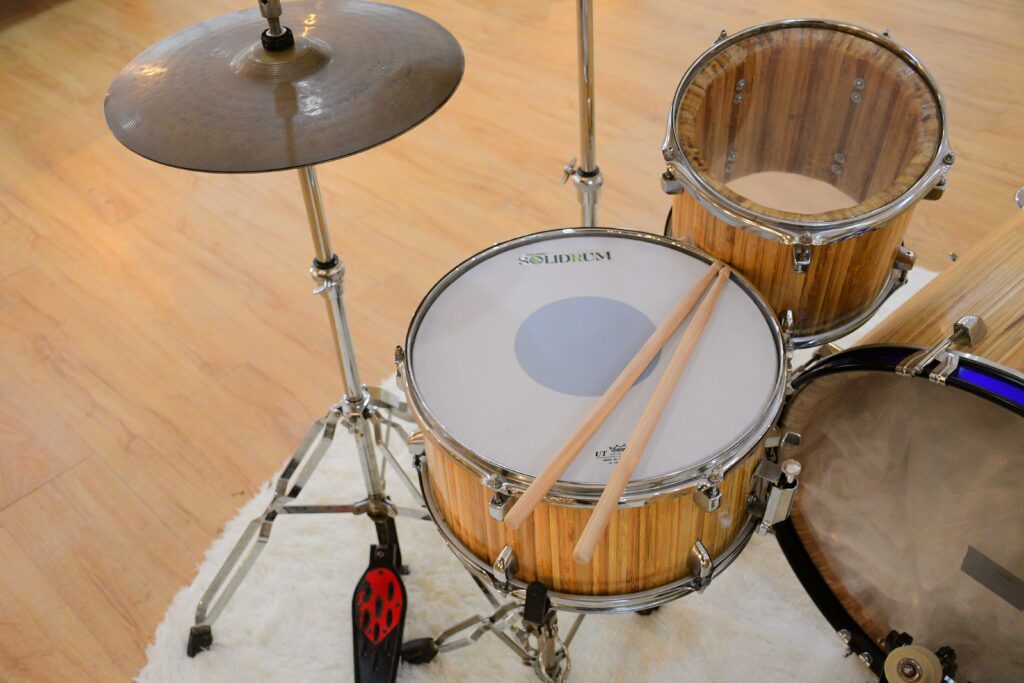A sound way to use a readily available resource.
Turns out, a drum kit made out of local engineered bamboo sounds really great.
“It has a dark and soft kind of hit,” said Rosendo “Toks” Paras.
Take it from Paras, who’s been in bands since he was 16 years old and now holds down the bass for the psychedelic rock outfit Dott Seki and the Seeds of Light. He’s also the founder and main craftsman behind Tree:ty Drums, a production and events sound system provider, and a maker of boutique handcrafted snares and full drum kits made from recycled materials.
“I usually make from old furniture and fallen trees,” said Paras. “I look for ways to make use of wood scraps that most people would consider useless.
By his count, Paras had made around 30 full drum kits and around 12 custom snares to date.

Earlier this year, around March 2025, DOST’s Forest Products Research and Development Institute (FPRDI) based in University of the Philippines Los Banos got in touch with Paras. Project leader Benjo Salvatierra and his team found Tree;ty from—out of all places—a Facebook group called Drummer’s Marketplace Philippines.
“It was where [Paras] showcased his handcrafted wooden drums,” said Salvatierra. “Seeing his expertise and commitment to high-quality local drum production, he was identified as a potential adopter of the bamboo drum shell technology.”
The project was to basically craft a prototype of a full drum kit—kick, snare, toms, and all the stuff you can hit—out of the bamboo slats that the scientists from FPRDI’s team would provide to Tree:ty as proof of concept.
Fast forward to June, about a month after the delivery of the materials to his workshop, and Paras has delivered the first bamboo-made drums to Salavatierra’s team.
By July 4, the Himig Agham Kawayan, the Institute’s in-house bamboo musical ensemble composed of researchers and staff, use this same prototype kit on stage when they played at the 68th anniversary celebration.
The launch at the Bellevue Hotel marked the public introduction of the bamboo drum kit and the other prototype instruments under the Institute’s “Gubat Obra” initiative, which has an S&T program mandate to make forest-based creative products.
The drum kit line made by Tree:ty had an official product sign by then: the Solidrum (after DOST Secretary Renato Solidum Jr.)

The humble Dendrocalamus asper (or giant bamboo,) as prevalent as any other fast-growth species in South East Asia, wasn’t really a prime candidate for a sustainable alternative to traditional hardwoods in drum-making.
“Preservation and prepping for usability are the main factors in making giant bamboo ready for craftsmen and artisans like drum makers,” said Salvatierra. “Because it’s prone to wood-boring pests and insects. The powderpost beetle which tunnel and infest bamboo is a big problem. Giant bamboo is very bukbukin.”
What it lacks in material sophistication it makes up for in ready availability. Giant bamboo trees typically grow in patches along riverbanks, cultivated areas, and in forest edges. The estimated total area of the species in the whole country goes up to a high end of about 53,000 hectares.
“It’s very sustainable and can be adopted as a source for large-scale supply when this project ramps up by 2026,” added Salvatierra. “Giant bamboo can regenerate within three to five years but the important part is we make sure that our tech can be easily adopted by craftsmen because getting the machines we used shouldn’t be too expensive.”
The Philippines has long been producing and processing bamboo products for various uses, including construction, furniture, and handicrafts. It’s one of the primary materials used for the classic Bayanihan-style image of our “bahay kubo.” Aside from daily use as fuel for cooking and heating, it can, of course, be made into musical instruments. However, bamboo as a drum kit shell isn’t the go-to ideal. High-end drums from big legacy brand manufacturers like Pearl and Mapex commonly utilize maple, birch, and mahogany.
For Paras, who’s been used to scrapping old furniture to upcycle into snares and toms, working with the DOST’s materials, as engineered as they already were by our local scientists, still presented challenges.
“During whittling and chiseling down there were hiccups,” said Paras. “Since I do everything manually, the tools would sometimes slide or go too deep because I was unused to their quirks.”
Paras continued, “There were unexpected bumps and knots in the wood. There were exceptionally hard parts where my chisel would go awry because of the unseen obstacle. So I had to eventually use a machine planer, an electric grinder, and other power tools.”
By Paras’s estimate, these issues, albeit minor, added two extra days to each stage of the four-week process—which meant about another week overall.
“The engineered bamboo slats are a bit brittle. This will definitely be a challenge in mass production, as it requires careful handling and attention to detail during the polishing process.”
To be made ready for use by craftsmen like Tree:ty Drums, DOST’s bamboo shells first go through kiln-drying with thermal modification. Likely the most vital factor in prepping bamboo into craft material, because it gets all the moisture out. Which in turn protects it from pests and from what’s called bioderegulation factors: bacteria and fungi growth.
The second step of the process is making it into engineered bamboo. This includes sanding the slats down and putting a thin laminate on, which makes these ready for structures like home furniture.
“We market that as an alternative to usual woods. With drum-making, this factor is important for making the layers into cylindrical parts.”
The results speak for themselves in the Solidrum prototype made by Tree:ty. The bamboo veneering, lamination, kiln-drying, and thermal modification to enhance the acoustic and structural properties transform a cheap and prevalent material into something that can be eventually mass-produced for university music colleges, high school and elementary after-school programs, and even make it into local gear providers like, maybe, RJ Music.
“I worked eight hours a day on it, strictly,” said Paras about the intense four weeks he solo crafted the Solidrum kit. “Sometimes I’d put in more hours when I am in the flow. I don’t stop when I start, it’s just the way I am.”
After everything was done and assembled, the kit had a dark and soft kind of sound that reverberated robustly when hit, mostly because Paras customized the bass drum into a 22 x 22 size.
“Rather than the standard 22 x 16, I used a size for my own preference, which is almost the same size as Vinnie Paul’s kit, the drummer of Pantera, who uses 24 x 24. At the launch, I enjoyed hearing someone else play my kit for the first time live!”
Aside from bamboo membranophones (where the rock drum kit falls under,) the FPRDI’s project has a target completion date for other prototypes by early 2026. These include bamboo wind instruments, percussion, and bamboo guitars, violins, and other stringed instruments.
“I really hope they make more of these bamboo drums and get them into their partner music schools and after-school programs,” said Paras.
Salavatierra echoed the same sentiment. “All our R&D projects need an end adopter that can be trained in their use for cultural and commercial purposes. The goal is to transfer the complete technology to interested adopters, starting with Tree:ty Drums and eventually expanding to other instrument makers across the country.”

By 2026, the project’s pre-commercialization activities should be completed, and then it will enter the next phase, which includes DOST’s scientists finalizing technical manuals for drum shell production, developing business models for local artisans and cooperatives, then conducting market readiness assessment and promotions.
“We hope to see bamboo drums widely used in schools, as part of efforts to localize music education,” said Salvatierra. “Also played in festivals and parades, showcasing locally-made instruments, and our Soldirum kits commercially produced by Filipino artisans, using Filipino materials and locally-developed technology.”
Perhaps one day, an aspiring young Filipino drummer will cut his chops on a Solidrum kit before going on to fame and sonic glory.



